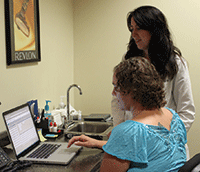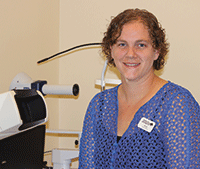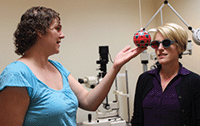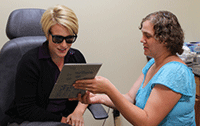Technician delegation is an essential part of my practice. Delegation has added to my bottom line, decreased my per patient workload and has made practicing more enjoyable. Prior to opening my own practice, I worked at several ophthalmology clinics and got to experience the benefits of delegating. This was something that I wanted to carry forward into my own practice.
When I opened cold in February 2012, I started with one employee who had no optical experience. I had just a handful of patients initially, so I did the entire exam from start to finish, including the materials selection and measurements. My appointment slots were 45 minutes.

| |
|
You must interpret the patient's data, but you don't need to collect it. That's just one reason for delegation, says optometrist Kara Gibbs. Her technician, Renee Haight, performs pretesting as well as vision therapy.
|
Over the years, my practice has grown to include three employees. Six months into the practice, I added an optician. One year in, I hired a front desk person who was also my technician. About 16 months in, I decided it was time to have a dedicated technician and a dedicated front desk employee. About nine months ago, I started offering vision therapy. About three months ago, my technician also took on the role of vision therapist. My appointment slots are now 15 minutes, with a few appointments double booked.
Revenue per patient can potentially be hundreds of dollars, so adding additional staff is a great investment because it allows you to increase your patient base. With my current staff, I now have the opportunity to see at least twice as many patients as I did before.
Also, your job as an optometrist is to interpret data, not to collect it. Being able to assess the data as a whole has made me a more effective clinician. It’s wonderful to simply review the technician’s testing results before I even walk into the exam room—I can really focus my attention on the problem at hand. It allows me some time to think about possible diagnoses. If I need additional clarification from the patient on their complaint, I have the time to ask. If I want additional testing done, we perform it that day or schedule the patient to come back for a follow-up.
Technicians are becoming standard practice in any health care setting. Primary care physicians, specialists and even dentists rely on technicians in some form. Patients have come to accept and expect to have an assistant/technician get them ready to see the doctor. Having a technician may improve patients’ perception of your practice and help you adapt to a medical model. I have yet to receive a complaint about a patient seeing the technician first.
How can you get started with a technician, or expand their responsibilities?
1. Hire the Right Personality
This is the most essential tip. The technician may spend as much time with the patient as you. Your technician is a direct representative of your practice and sets the tone for the exam. It is important that they be friendly and professional at all times.
|
You Need a Renee!
My technician/vision therapist Renee is an integral part of my practice. She has improved our patient flow, which allows me to see more patients more effectively. Renee performs many tests—from documenting the patient’s history to taking retinal photos—which I used to think I had to do myself.
She is also responsible for several other tasks, such as keeping the exam room supplies stocked, opening and closing the exam lane, cleaning the equipment before each patient, and communicating with me after each vision therapy session. |
Your technician must be comfortable communicating with your patients. Don’t hire someone who is not comfortable with children if you have a pediatric practice. Also, there will be times when more than one patient is waiting for the technician. The technician must be able to multitask and work quickly. (See “You Need a Renee!” above.)
2. Decide What to Delegate
Be honest with yourself: you are experienced with testing, but almost anyone can be trained to perform these tests and record the results. It’s the interpretation of the results in which our expertise resides. Instead of collecting and inputting data, you can spend more quality time with patients.
For example, my technician Renee is trained to dilate patients for comprehensive exams and certain follow-ups. She knows not to dilate patients with elevated intraocular pressure or those with specific eye conditions. If she is ever unsure, she first confirms with me.
So, decide which essential items you must do or want to perform, and what you can delegate. (See “Tasks and Tests You Can Delegate,” page 44.) Check your state laws to make sure that these tests may be delegated to a technician.
3. Consider Your Available Space
Your technician will need a private area to perform pretesting. This could be done in the exam room or in a separate work-up area. For instance, our office has two exam rooms. I use one room to examine patients and Renee uses the other for pretesting and vision therapy sessions. The second exam room also contains an automated perimeter and fundus camera.
Specifically, after Renee is done pretesting, she escorts the patient into the primary exam room. She lets me know the patient is ready and I review the patient’s chart before entering the exam room. I do a few entrance tests and refract before dilation has set in. I enter the testing information from the EHR system, and then perform the dilated portion of the exam.
Meanwhile, Renee is pretesting the next patient.
4. Train Properly
The technician must feel comfortable with their duties or patients will pick up on nervousness. Have the technician shadow you until they are comfortable with the workflow. Then watch as they perform the tests and input the results. They may be more comfortable first practicing on you or a staff member before moving on to patients. Make sure to stress accuracy first and then work on speed.
Documentation instruction is just as important as performing the test. If you use an EHR system, the technician must know where to put the test results. Technicians must also be aware of any testing results outside of normal that require your attention or that would trigger additional testing.
Technicians must know what testing to perform for each type of encounter and over each age range. You’ll want different testing performed on a one-year-old vs. a 45-year-old. You’ll want different testing for a new patient comprehensive exam vs. an “IOP check.”
Another thing to stress to the technician is that they are not to give medical advice or provide testing results to the patient. If a patient asks a medical question, have them say, “That’s something we can ask the doctor.” Then have the technician make a note for you to address the question during the exam. The technician needs to be well versed in your office policies and fees, as this is where many patients will ask those types of questions.
At the end of the day, it is a good idea to touch base with your technician. Talk about how patient flow went, if they have any questions about testing, etc.
5. Be Ready to Adjust Your Schedule
It will take some time until the technician gets up to speed. You can simply decrease your patient volume. Another option is to keep your volume the same and you can see patients simultaneously, as needed, if your workspace allows. Although this can be frustrating, especially if you have a busy schedule, it is necessary. Most patients are very accommodating if you tell them that you are training. I found that, after a few months, my technician was faster than I am.
Tasks and Tests You Can Delegate
• Medications and allergies
|
Of course, I’d love my schedule to be fully booked, but there are still some slow days. I have my staff make the best of their time when they are not busy with patients. With stagnant or decreased insurance reimbursements, I make sure they have something useful to do. They can follow up on reports, work on billing, market the practice, clean the office, get together for staff meetings, etc.
6. Invest in Staff Education
As new technology becomes available or you add additional services to your practice, your technician will need further training. My practice has added vision therapy services over the last year. I started out performing the sensorimotor exam, developmental testing and vision therapy sessions myself. My technician is now training as a vision therapist and she also performs the developmental testing and some elements of the sensorimotor exams. Getting Renee comfortable to perform vision therapy sessions has required extensive training.
The right person will be excited about the increased responsibility. With vision therapy sessions lasting about 40 minutes, this is a huge time saver for me while still increasing revenues.
You should make it clear that ongoing education is important as well. I show her any beneficial journal articles I come across. Furthermore, our office staff attends multiple continuing education conferences through out the year. Employees view this as a job perk and are excited to attend. The practice covers the cost of attendance, travel, meals and their time.
Now that you delegate more, you must decide what to do with your extra time. This is the easiest and the most enjoyable step. Use your time to see additional patients or spend more quality time with each patient to make individualized recommendations. Other options are working on administrative tasks, marketing your practice or simply scheduling more personal time away from the office.
Remember, the doctor’s time is the most valuable in the practice. Having a well trained and personable technician will save you time, add opportunity for increased revenue, elevate patients’ perceptions of your practice, decrease your workload and improve your professional outlook.
Dr. Gibbs is in solo private practice in Jamestown, NY.




